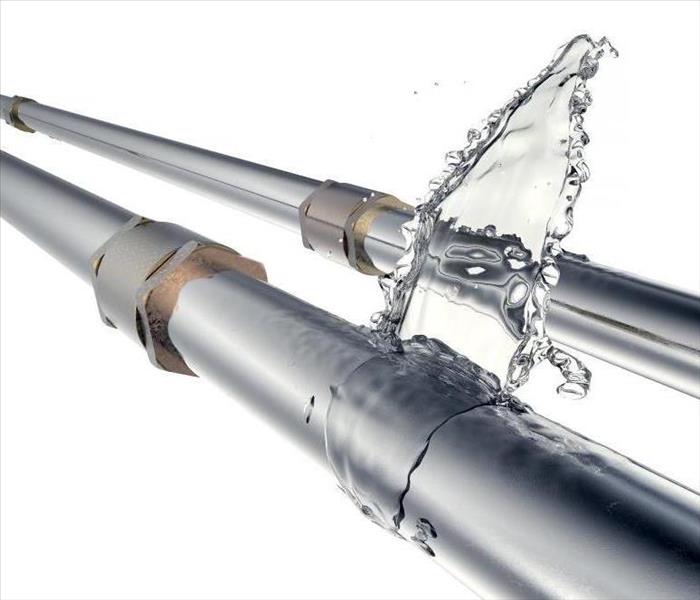How Do I Remove Water After a Pipe Breaks in the Wall of My Westerly House?
6/21/2020 (Permalink)
Finding and Removing Trapped Water Is a SERVPRO Specialty, Meeting a Common Need in the Westerly Community
Whether you are coping with aging clay pipes in a historic Westerly home, or burst polyvinyl chloride (PVC) conduit in newer construction, when a supply line breaks, water damage issues remain even after plumbing repair. Water spewing from the pipe can collect between walls and in other cavities, soaking into and damaging building materials and threatening injury to you and your family from ceiling or wall collapse.
What Direction Can I Expect the Water to Migrate?
Locating water for removal in your Westerly’s home’s hidden building cavities requires professional assessment. It is nearly impossible to predict the pathway the water might follow after the leak or pipe break. Yet, it is essential to determine where the water moved and if it collected, absorbed into structural components, or both. Standing water can pool behind baseboards, under the top layers of hardwood floors, and over ceilings, among many other places. You might find that the damage was more long-standing than you believed. A burst pipe can be the culmination of a persistent slow leak, with unmistakable water loss, compounding the harm done by seepage now discovered but unknown earlier.
How Can the Water’s Path be Discovered and Traced?
SERVPRO’s managers and technicians master techniques to find and follow the water’s wanderings during coursework taken at the Institute of Inspection, Cleaning and Restoration Certification (IICRC). Among the vast catalog of water damage restoration best practices, our employees focus on learning both the theory and application of water tracking. Specifically, the training introduces our technicians to the following sensitive and useful devices:
Moisture Sensor
A moisture sensor uses sharp probes to detect moisture in soft materials. When the sensor encounters wetness, it alerts the operator with a flashing or steady light and a beeping sound. The sensor is essential to begin creating a “map” of the moisture the broken or cracked pipe caused to escape into building materials, cavities, and fixtures.
Moisture Meter
Once the moisture sensor locates the wet areas and materials in Westerly, our Water Damage Restoration Technician (WRT) switches to a metering tool that measures the moisture content of the affected structural components or fixtures. Our team must gather data on the moisture levels of damaged areas to give us a baseline against which to compare changing moisture levels during drying efforts. Moisture meters need to be calibrated for the materials tested. When used to monitor drying activity, they also might require an average of multiple readings from different areas for the most accurate result.
Penetrating Moisture Meters
Designed to use integrated probes to test inside building cavities and under the strips or planks of hardwood flooring. This type of meter can also test individual layers of building materials.
Non-Penetrating Moisture Meters
These meters use sensors to confirm moisture readings when held against surfaces. The mechanism used to reach a determination is how conducive the material is, which can result in skewed readings when metal materials are adjacent to the tool, such as steel framing, screws, nails, and foil-backed insulation. This tendency is another reason why several readings need to be taken by a trained and experienced technician.
Note: We recommend that the same individual perform the testing throughout the project to obtain as much consistency as possible.
How Is Trapped Water Removed After Location and Measurement?
Once the professional detection and metering tools have directed our employees to the spaces where water collected and materials absorbed moisture, the team gets busy. We remove standing water with submersible pumps and extractors, the latter both truck-mounted and portable. Water that is hard to suction out even with extractor wand extenders needs help with release. After extraction, our drying equipment also requires access to wet cavities. We use controlled demolition to meet both challenges, opening areas that otherwise would hold moisture, reasoning that drywall and ceiling tiles are reasonably inexpensive and straightforward to replace. The methods we employ include:
- Flood cuts in walls, from floor level to several inches above the waterline, completely opening the space for drying
- Prying off baseboards and drilling holes to drain water and permit warm, moving air to direct inside during the drying phase
- Drilling holes in mortar joints in cinder block and other masonry construction for fluid release and drying
SERVPRO of Washington County has the trained technicians, moisture detection tools, and extraction equipment required for rapid water removal. Call (401) 315-2337 24 hours a day, seven days a week. We’re Faster To Any Size Disaster.






 24/7 Emergency Service
24/7 Emergency Service
